Illuminating Humanities: Margaret Ezell & Kevin O’Sullivan
Highlighting Humanities Research and its Impact
Margaret Ezell and Kevin O'Sullivan | English
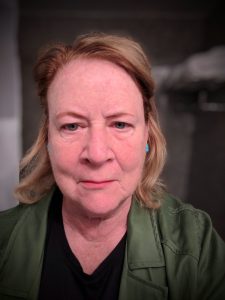
Dr. Margaret Ezell, Distinguished Professor, English, Texas A&M
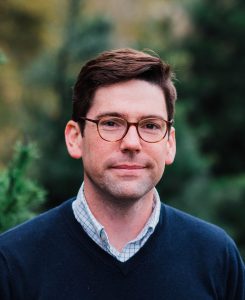
Kevin O'Sullivan, Assistant Professor, English, Texas A&M
The Glasscock Center is excited to continue its series which highlights humanities research at Texas A&M, and the vital role played by the humanities at the university and in the world beyond the academy.
For this highlight, we invite Dr. Margaret Ezell and Kevin O'Sullivan to tell us about their Folger Institute Faculty Workshop, "Making Meaning: Hands-On Basic Paleography and Book Production."
Tell us a bit about your project under the Folger Institute Course.
Thanks to the generous support of the Glasscock Center (which pays the dues for A&M’s membership in the Folger Institute Consortium) A&M faculty, graduate and undergraduate students have been enjoying the benefits of attending seminars, symposia, and workshops sponsored by the Folger Institute in Washington, DC. A&M became a member of this prestigious Institute in 2004, one of only 46 in the US, UK, Canada, and Ireland. When the Folger Shakespeare Library, the home of the Institute, closed for renovations, we submitted in 2019 a successful competitive grant to host a workshop at Texas A&M. This week-long residential workshop was supposed to be held here in July of 2020, but covid forced its delay until this summer. It was an intensive course involving hands-on experiences, learning to make and use 16th and 17th-century writing materials, from cutting the feathers for quill pens, making paper and ink for handwritten texts, to creating the metal type for printing, setting type and printing it on a wooden press, and binding books. Each student worked with both types of media each day and by the end had created their own “hybrid” book, which contained recipes for making different inks found among contemporary sources.
What inspired your interest in this topic, and why is it significant?
ME: I taught myself how to read 16th and 17th-century handwriting as part of my research as a literary historian, but it was not until the last few years that I had the chance to try actually writing with a feather quill! It was eye-opening to me how much more sense certain types of writing and formatting of letters and poetry made to me once I used the same writing tools as the original writers did. I later had the chance to learn here at A&M’s Book History Workshop how early modern books were printed and all the steps involved in that; that experience made me wonder about how those two types of writing were related, and how the historical changes from handwriting to print resemble what’s now going on with our shift from print to digital media and how it affects the ways we read and the type of texts we create.
KO: I had the great fortune of attending the Book History Workshop soon after my arrival at Texas A&M. At that time I already had a deep and abiding interest in rare books from the perspective of a reader, but did not know much about the physical labor that went into producing them. Attending that workshop a decade ago was a watershed moment for me. I soon joined the faculty of the program and have directed it since 2016. While our course for the Folger Institute was its own unique endeavor, in many ways it built upon the curriculum Margaret and I have each enjoyed in the Book History Workshop. In particular, both courses are predicated on the importance of first-hand knowledge of these textual technologies: Experiencing the processes through which books from the early modern period were produced fundamentally alters the way we understand them as objects as well as the manner in which we as readers derive meaning from their physical form.
What did you find rewarding in your work?
ME: I always learn as I am teaching, and this workshop was no exception. Every day was exciting and challenging. It was also a delight working with two such skilled artisans, Kevin, who is a master printer, and Lucas Tucker, a professional scrivener (scribe) who joined us to demonstrate his craft in recreating authentic early modern writing implements such as inks, quills, and other items related to creating manuscripts.
KO: It was an absolute joy to think through the issues taken up by this course with Margaret as well as the several undergraduate and graduate students who helped shape the course. The conversations among the participants throughout the week were equally thoughtful, raising as many questions as they sought to answer. From a practical standpoint, I came away from the week with a much greater understanding of early modern English handwriting both from the perspective of paleographer (one who seeks to read it) as well as scrivener (one who creates it).
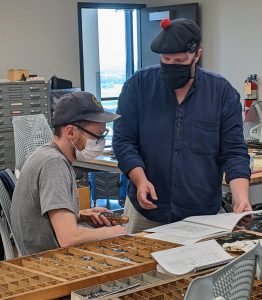
Instructor Lucas Tucker assists a student with typesetting.

Quill practice by TAMU-English PhD student Alex LeGrand.
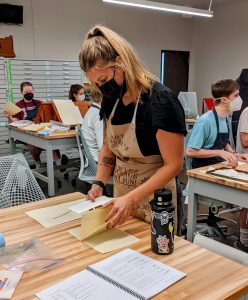
Instructor Michaela Baca reviewing students’ progress in a completed hybrid book.
Why are the humanities and humanistic social sciences important to society as well as to you personally, especially in the current moment?
"The humanities are of vital importance, especially today when decisions are being implemented by policy makers on the basis of 'history' or 'precedent.'”
ME: As Kevin says, the point of humanities is to enable you to look with more care and insight into the past as well as the present, to see what we know about the past in terms of how we come to know that. Sometimes when you go back and look at the original sources and situations or you experience creating something first-hand, you realize the gap that can lie between what we have been taught by others about the topic and what experiences in the past were like.
KO: One of the great services the humanities provide is the way they encourage us to think critically about our world and how we interact with it. The “Making Meaning” course was organized, in part, around the questions: By what means are texts produced? What aspects of texts are read, and how? While these questions were made material in the course through activities like writing with quills, casting lead type, and printing on an English common press, they are equally as relevant to our current media-saturated moment as they are to the study of early modern textual culture.
Besides your work, what is something you are passionate about?
ME: I really enjoy living on our small farm outside of Hearne. Thanks to COVID, I found myself becoming much more interested in growing things, such as our own vegetables and herbs, as well as being with the animals wild and tame who live out here and watching them be happy.
KO: It is a bit of an occupational hazard, but I am a modest collector of books and records. That said, much of my free time is devoted to two small children who are equally passionate about books (and very much enjoy my reading to them).
What are some future research projects that you are, or want to, work on?
ME: I have two projects at the moment, one which is exploring the ways in which late seventeenth-century and early eighteenth-century English periodicals basically behaved in very similar ways to how social media does today, with interactive and multimedia experiences to attract and hold its audience. The other project is more historical in nature and involves looking at the lives and activities of a group of mid-17th -century women printers, who lived in the same London neighborhood and survived multiple husbands, the English civil war, and the Great Fire.
KO: I am currently working on a project that explores the manner in which Elizabethan writers involved in the colonization of Ireland utilized the georgic mode to aestheticize their experience. In addition to this, I have an ongoing role in the 3Dhotbed project, which is a collaborative digital humanities effort that seeks to enhance book history instruction through 3D technologies. We have recently begun to expand the corpus of datasets and supporting contextual materials through new partnerships, which should keep me busy for some time to come.
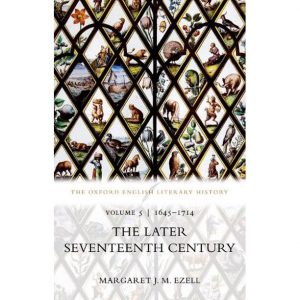
The Oxford English Literary History: Volume V: 1645-1714: The Later Seventeenth Century, by Margaret J.M. Ezell
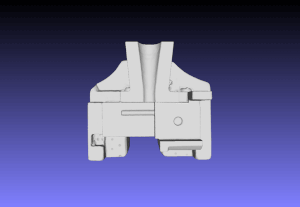
Figure 1. Rotating gif of Moveable Hand Mould Side A. One piece of a two-part mould used for casting hand-made type. Slid together, the two parts of the mould create a cavity that adjusts for varying letter widths. A typecaster inserts a matrix for a specific letter into the hand mould and fills the resulting cavity with molten type metal, creating a piece of type (Jacobs, McIntosh, and O’Sullivan 2017).
